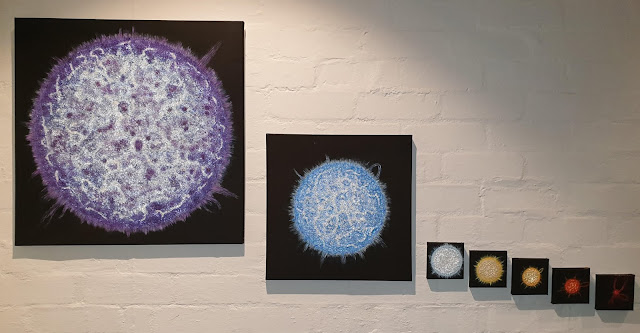In order, then: I finished a Christmas present for Christian, another student from Germany who started this year. He's working on another aspect of the larger project my PhD is a part of. My project involves measuring the value of the fine-structure constant, using solar twins, or stars similar to our Sun. His project involves finding more solar twins, at greater distances in the Milky Way, to be used as targets for my work. Anyway, because of that, I decided to paint him a little solar twin of his own. And for fun, I named it “Sonne Doppelgänger” (solar twin in German).
 |
| “Sonne Doppelgänger”, 20×20 cm, acrylic with glass beads on canvas. |
Speaking of presents, I finished another piece intended as a gift for the new director of our department, who'll be starting officially in March but will be here in Melbourne next week, and attending the Christmas party the week after that. As she works on galaxy formation and globular clusters, I figured I'd do a nice painting of a galaxy, but didn't really have a good idea of exactly what until a few weeks ago. Then, I had an amazing idea: paint a picture of a galaxy, then paint several globular clusters on little wooden disks which could be positioned on the canvas with magnets. Repositionable globular clusters! I loved the idea so much I went out and bought a canvas and started painting it the same day. I've been working on the various pieces involved, ordering magnets, and so on, and last night it finally all came together. Behold:
 |
| “Galaxy in Motion,” 40×30 cm(?) acrylic on canvas, with acrylic and glass beads on wooden disks and magnets. |
 |
| Two globular clusters and associated magnetic handles. |
Finally, perhaps the coolest thing to happen this week is that we got permission to hang some of our artwork up in the stairwell in the building I work it at uni. (Funnily enough, it was originally the art building for the university, as shown in the letter designation it still keeps, ‘AR.’) Last week we blocked out where about half the works we had in mind would go, and Tuesday I came in to find someone in the process of hanging them up. This initial batch of 17 pieces only includes my star series from me, but I've got another piece that's nearly finished and Tenuous Transport ready to go up when we get everything together for the second wave.
Anyway, you've seen my star series before, but I just couldn't help taking another picture of them, finally hung the way I'd always envisioned, in a manner reminiscent of the main sequence on the Hertzprung-Russell diagram they were inspired by:
So those are some of the things I'm especially thankful for this Thanksgiving, among others. Hauʻoli Lā Hoʻomaikaʻi, (happy Thanksgiving) everyone! A hui hou!
